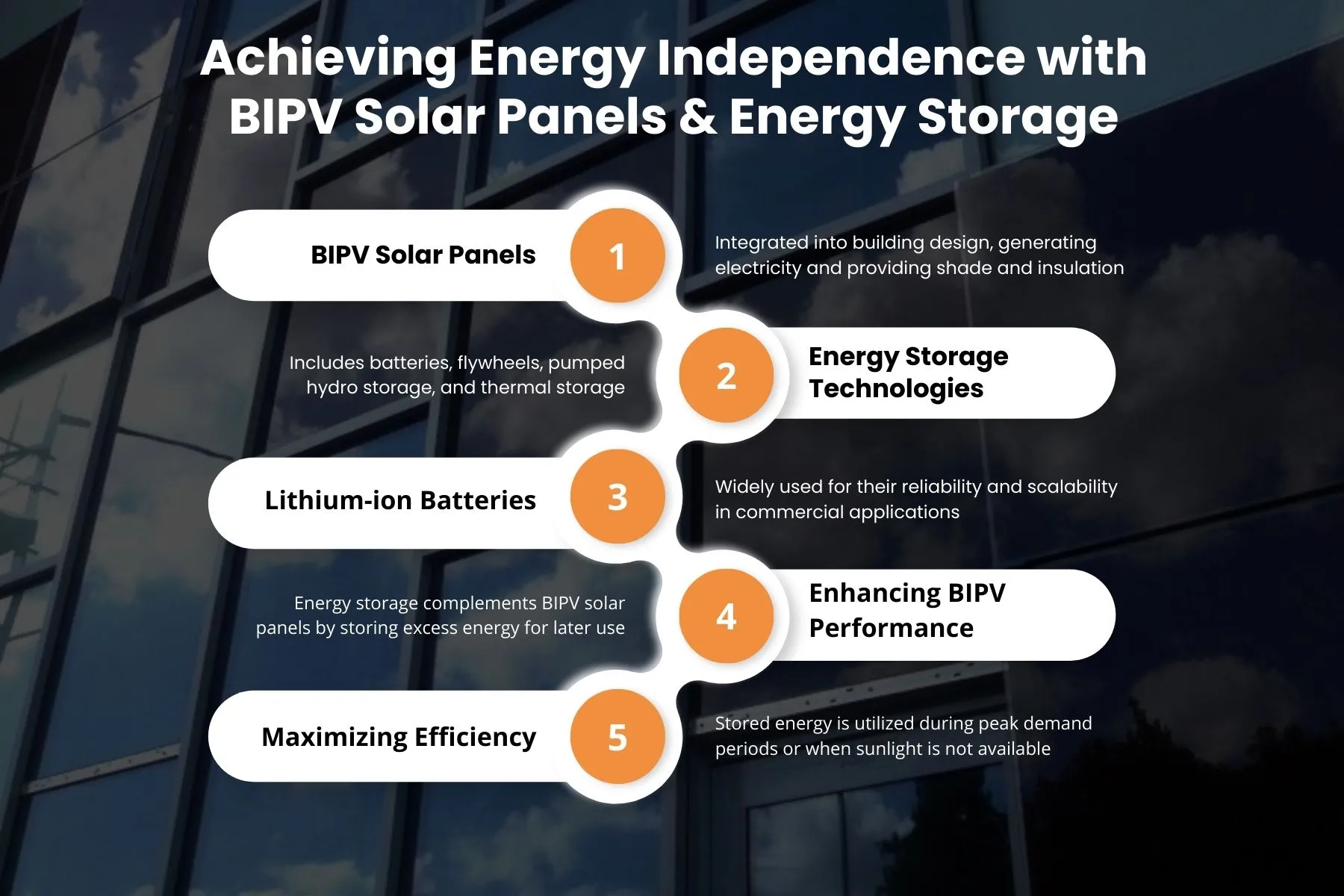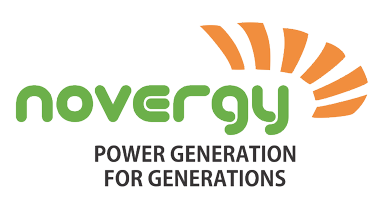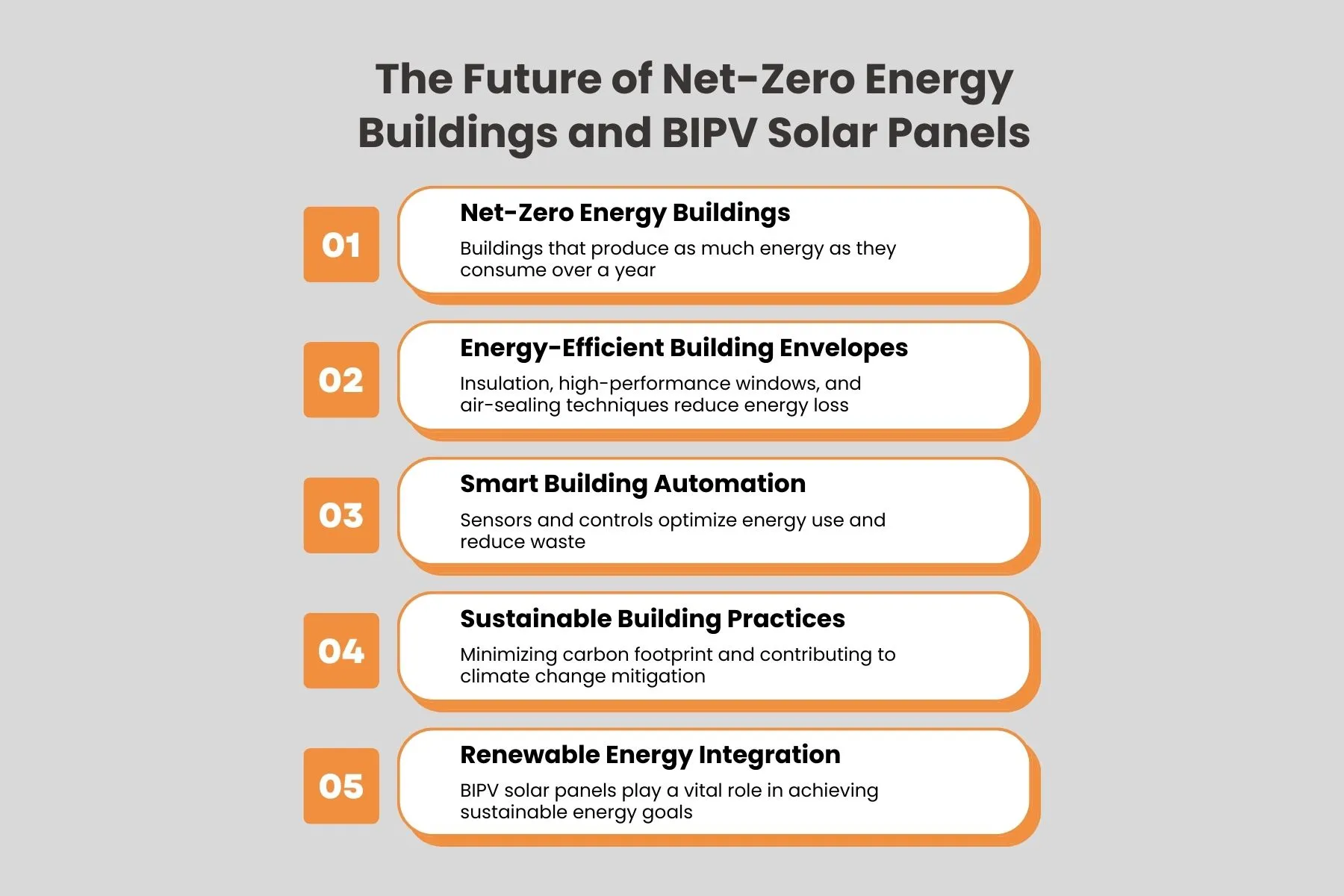In today’s world, where climate change is a pressing concern, energy-efficient buildings have become a necessity. Two significant concepts that are gaining popularity in this regard are BIPV solar panels and net-zero energy buildings. Building Integrated Photovoltaic solar panels are a form of renewable energy technology that is incorporated into building structures to generate electricity. On the other hand, net-zero-energy buildings are designed to produce as much energy as they consume, resulting in a zero-energy balance.
In this blog, we will explore the meaning of BIPV solar panels and net-zero energy buildings and discuss the importance of achieving energy independence in buildings.
Why should you opt for BIPV Solar Panels?
Opting for building-integrated photovoltaic (BIPV) solar panels brings numerous advantages. BIPV systems generate clean and renewable energy, promoting energy independence and reducing carbon emissions. They efficiently utilize available space by integrating seamlessly into building materials, offering aesthetic appeal. While the initial costs may be higher, BIPV panels provide long-term cost savings and a positive return on investment. They are durable, require minimal maintenance, and offer design flexibility, enhancing architectural integration. BIPV panels contribute to a greener future and improved building performance by reducing reliance on fossil fuels. Choosing Novergy’s BIPV solar panels is a wise decision that aligns with sustainability goals and benefits both the environment and building owners.
Why are Net-Zero Energy Buildings Important?
Net-zero energy buildings are of utmost importance in our pursuit of sustainability. These buildings can generate as much energy as they consume, resulting in minimal environmental impact. They effectively combat climate change by reducing greenhouse gas emissions and promoting energy independence. Net-zero energy buildings also save costs in the long run by minimizing energy consumption and offering resilience in the face of fluctuating energy prices.
Importance of Achieving Energy Independence in Buildings
Energy independence in buildings is becoming increasingly important due to the rising cost of energy and the environmental impact of fossil fuels. By implementing BIPV solar panels and net-zero energy building design, buildings can generate their own electricity, reducing their reliance on traditional energy sources. This can result in significant energy savings, lower carbon emissions, and increased energy independence. Achieving energy independence in buildings is crucial to reducing our dependence on fossil fuels and creating a sustainable future.
Designing Net-Zero Energy Buildings with BIPV Solar Panels
In recent years, the use of Building Integrated Photovoltaic (BIPV) solar panels has gained significant popularity in the construction industry, especially in the design of energy buildings. A net-zero energy building is a structure that generates as much energy as it consumes on an annual basis, resulting in zero net energy consumption.
Incorporating BIPV solar panels into building design can help achieve this goal by harnessing the power of the sun to generate electricity. BIPV solar panels are integrated into the building envelope and serve both as a source of energy and a building material, reducing the need for additional cladding and roofing materials.
To maximise the energy efficiency of net-zero-energy buildings, a number of strategies can be employed. Firstly, the building envelope must be designed to minimise energy loss through insulation, airtightness, and high-performance glazing. The orientation of the building also plays a critical role in maximising solar gain and reducing energy demand.
BIPV solar panels must be optimally oriented and shaded to ensure maximum energy generation. In general, the optimal orientation of BIPV solar panels is south-facing in the northern hemisphere and north-facing in the southern hemisphere. Additionally, the angle of the panels should be adjusted to match the latitude of the building site to capture the maximum amount of sunlight throughout the year.
Shading analysis is also crucial in designing net-zero-energy buildings with BIPV solar panels. Shading from nearby buildings, trees, and other obstructions can significantly reduce the energy generation of the panels. Therefore, it is essential to assess the potential shading impacts during the design phase and incorporate shading devices, such as overhangs, louvres, or screens, to mitigate these effects.
How BIPV Solar Panels Contribute to Net-Zero Energy Buildings
These solar panels are designed to be integrated directly into the building’s construction materials, such as roofs or walls, instead of being mounted on top of them.
Net-zero energy buildings are those that produce as much energy as they consume, resulting in an energy balance. This is achieved through a combination of energy efficiency measures, such as high levels of insulation and energy-efficient lighting and appliances, and renewable energy generation, such as through BIPV solar panels.
Technical aspects of BIPV play a crucial role in realizing net-zero energy buildings by seamlessly integrating renewable energy generation into the building envelope. BIPV panels incorporate solar cells directly into building materials such as glass, roofing, or facades, efficiently capturing sunlight and converting it into electricity. These panels offer design flexibility, allowing architects to customize their appearance and seamlessly integrate them into various architectural styles. With high-efficiency solar cells, BIPV panels maximize energy conversion and generation. They are connected to the building’s electrical system, enabling efficient distribution and utilization of the generated electricity. BIPV systems can be integrated into building energy management systems, allowing real-time energy usage monitoring and optimization.
Compared to traditional solar panels, Novergy’s BIPV solar panels have several advantages. One of the main advantages is their aesthetic appeal. BIPV solar panels can be designed to blend seamlessly into the building’s design, making them less obtrusive than traditional solar panels.
Another advantage is their dual functionality. By serving as both a building material and a renewable energy generator, BIPV solar panels can reduce the overall cost of construction and energy generation.
By lowering the amount of heat that the building’s roof or walls absorb, BIPV solar panels can also increase the building’s energy efficiency by lowering the cooling load necessary to maintain comfortable temperatures inside the building.
BIPV solar panels are a promising technology for contributing to net-zero-energy buildings. As the world continues to move towards a zero-energy building future, BIPV solar panels are likely to play an increasingly important role.
Achieving Energy Independence with BIPV Solar Panels and Energy Storage
Achieving energy independence has become a crucial objective for individuals, businesses, and governments alike. One approach to achieving energy independence is through the use of BIPV solar panels combined with energy storage technologies.
Energy storage technologies come in many forms, including batteries, flywheels, pumped hydro storage, and thermal storage. Batteries are currently the most commonly used form of energy storage due to their reliability and scalability. Lithium-ion batteries, in particular, have become important for commercial use.
How Energy Storage Can Enhance the Performance of BIPV Solar Panels?
BIPV solar panels are integrated into a building’s design and serve a dual purpose of generating electricity while also providing shade and insulation. However, their performance can be affected by factors such as weather conditions and the time of day. By combining BIPV solar panels with energy storage, excess energy generated during the day can be stored and used during peak demand periods or when there is no sunlight. This helps to maximize the efficiency of the BIPV solar panels and ensures a steady supply of electricity throughout the day and night.
The Economic Viability of Net-Zero Energy Buildings with BIPV Solar Panels
The rising global focus on sustainability has led to a growing popularity of net-zero energy buildings.One of the key technologies that enable such buildings is building-integrated photovoltaic solar panels. These panels are not only aesthetically pleasing but also have economic benefits in terms of reducing energy costs and increasing the value of the building.
The economic viability of net-zero energy buildings with BIPV solar panels is an attractive proposition for business owners. These buildings generate enough energy to meet their energy demand, with any excess energy being sold back to the grid. This leads to a significant reduction in energy bills and, in some cases, even a net positive cash flow.
The costs of constructing a net-zero energy building with BIPV solar panels can be higher than that of a traditional building. However, the long-term savings from reduced energy bills and potential income from selling excess energy can offset these costs.
One financing option for net-zero energy buildings is through energy service companies. These companies provide upfront funding for the installation of energy-efficient measures, such as BIPV solar panels, and then receive a share of the savings over a set period. This allows business owners to make the necessary upgrades without upfront costs.
Incentives for net-zero energy buildings include tax credits, grants, and rebates. These incentives can reduce the initial investment costs and provide ongoing financial benefits for business owners.
The long-term savings and return on investment for business owners with net-zero energy buildings are significant. These savings come from reduced energy bills, potential income from selling excess energy, and increased building value due to its sustainable features. A net-zero energy building with BIPV solar panels can pay for itself over time, leading to a positive cash flow for the business owner.
The Future of Net-Zero Energy Buildings and BIPV Solar Panels
The future of net-zero energy buildings and BIPV solar panels looks bright with advancements in technology and design. BIPV solar panels are an innovative way to harness solar energy by integrating solar panels into building design. These panels can be incorporated into roofs, walls, and even windows, making them an integral part of the building’s structure.
Advancements in BIPV solar panel technology and design have made them more efficient and cost-effective. New materials, such as thin-film photovoltaics, are being used to create flexible and lightweight solar panels that can be easily integrated into building facades.
Net-zero energy buildings are becoming increasingly popular as people recognise the need for sustainable and energy-efficient buildings. These buildings produce as much energy as they consume over the course of a year. This is achieved through a combination of energy-efficient design, renewable energy sources, and energy storage systems.
Emerging trends and innovations in net-zero energy buildings include the use of passive solar design, energy-efficient building envelopes, and smart building automation systems. Passive solar design uses the sun’s energy to heat and cool a building naturally, reducing the need for mechanical systems. Energy-efficient building envelopes use insulation, high-performance windows, and air-sealing techniques to minimise energy loss. Smart building automation systems use sensors and controls to optimise energy use and reduce waste.
The role of BIPV solar panels in achieving global energy sustainability goals cannot be overstated. By integrating solar panels into building design, BIPV panels can help reduce the carbon footprint of buildings and make a significant contribution to the fight against climate change.
Parting Thoughts
The adoption of building-integrated photovoltaic (BIPV) solar panels has the potential to revolutionise the way we approach building design and energy consumption. The goal of achieving net-zero energy buildings, where the total amount of energy consumed is equal to the amount of energy produced on-site, can be reached with the implementation of BIPV solar panels.
The benefits of BIPV solar panels are numerous, including reducing carbon emissions, providing a reliable source of renewable energy, and increasing energy independence. However, there are also challenges associated with BIPV solar panel installation, such as cost, maintenance, and system integration.
Despite these challenges, it is crucial that Business owners, designers, and policymakers prioritise energy independence and net-zero-energy buildings. By doing so, we can decrease our reliance on non-renewable sources of energy and our carbon footprint.
It is our collective responsibility to promote and prioritise the implementation of BIPV solar panels in building design and construction. Let us work together to create a more sustainable future by embracing the concept of zero-energy buildings.
Buy Novergy BIPV solar panels and be hassle-free for life. With over 16 years of experience, Novergy has successfully solarized industries and corporations, making them a trusted integrated solar player. Their comprehensive services cover everything from planning to design and execution, offering a convenient one-stop solution.
To know more visit our website.


